The biggest challenge for any service team is not a lack of good ideas, but the gap between what stakeholders ask for and what the team actually delivers. Closing this gap is the key to accelerating service delivery and ensuring every effort contributes to the right outcome. This is where effective requirements management software becomes a team’s most valuable asset, creating a direct line from request to resolution.
We designed this guide to equip you with the essentials of requirements management. Take a few minutes to read on below and you will gain insight into platform capabilities, discover the key features needed for success, and learn how to select the optimal solution for your unique team process.
You can also check out our handy reviews of the top tools available in 2026 to make a confident, informed decision.
Key takeaways
- Traceability is the foundation: the core function of effective requirements software is creating complete traceability, linking every requirement directly to its design, code, and test case, to provide total visibility from project initiation to launch.
- Integration accelerates delivery: modern platforms excel when they integrate requirements documentation directly into service delivery workflows, transforming static requests into clear, actionable tasks for immediate team execution.
- AI acts as a strategic partner: advanced AI capabilities help teams shift from reactive management to proactive success by intelligently routing requests, flagging potential risks, and accelerating the entire requirements lifecycle.
- Collaboration requires centralization: frictionless collaboration is achieved by using a single platform that consolidates communication and documentation, eliminating version-control conflicts and fragmented email threads among cross-functional teams.
- Flexibility is crucial for adoption: the ideal platform must be intuitive and accessible to both technical and non-technical stakeholders (like monday service), allowing for no-code customization to perfectly match the team’s unique methodology (Agile, Scrum, Waterfall).
What is requirements management software?
Requirements management software functions as a central, authoritative playbook for a project team. It provides a dedicated space to define the precise scope and purpose of a project, ensuring every contributor works from the same set of plans from kickoff to completion. This strategic alignment is the most effective defense against miscommunication and expensive rework.
More than a simple documentation platform, it forges a direct link between stakeholder expectations and development deliverables. The software ensures all parties have a voice from the initial concept to the final approval, which maintains transparency and keeps the entire project on schedule.
The platform’s true value is realized when these requirements are integrated directly into project workflows. With solutions like monday service, stakeholder needs are transformed into clear, actionable items that teams can execute immediately. This approach shifts the focus from discussing what needs to be done to actively accomplishing it.

Why do teams need a requirements management system?
A centralized system for managing requirements helps teams navigate last-minute changes, keeping progress on track and maintaining clarity. This lack of a single playbook can entangle even the most efficient teams in delays and rework, a common but avoidable obstacle.
Requirements form the structural foundation of any project; ambiguity or disorganization introduces significant risk. An effective system establishes a single source of truth, guaranteeing that every task and decision aligns with the original objective. This clarity enables teams to adapt to changes effectively without losing sight of the overarching goal.
Implementing platforms like monday service allows teams to shift from chasing scattered details to building unified momentum. By connecting requirements directly into established workflows, the entire team gains the visibility needed to move forward with confidence and speed. The objective is to create a clear, shared path for delivering exceptional results.
Key features of software requirements management
Complete traceability is the cornerstone of effective requirements management, but modern success relies on combining this with intelligent action and seamless teamwork. These features promote clear understanding and ensure all requirements are addressed, providing total visibility from initiation to launch.
Key capabilities that accelerate service delivery include:
- Complete traceability: every requirement must be linked to its corresponding design, code, and test case, creating a transparent map of the entire development process for total visibility.
- Intelligent automation: built-in AI and automated rules empower teams to focus on high-value work by intelligently routing requests, triggering approvals, and flagging potential roadblocks before they materialize.
- Seamless collaboration: consolidating communication and documentation eliminates version-control conflicts, streamlining operations and improving resolution times, which ultimately leads to a superior customer experience.
Platforms that integrate these features, such as monday service, create a single source of truth where everyone contributes in real-time, effectively transforming requirements management from a manual burden into a strategic asset.
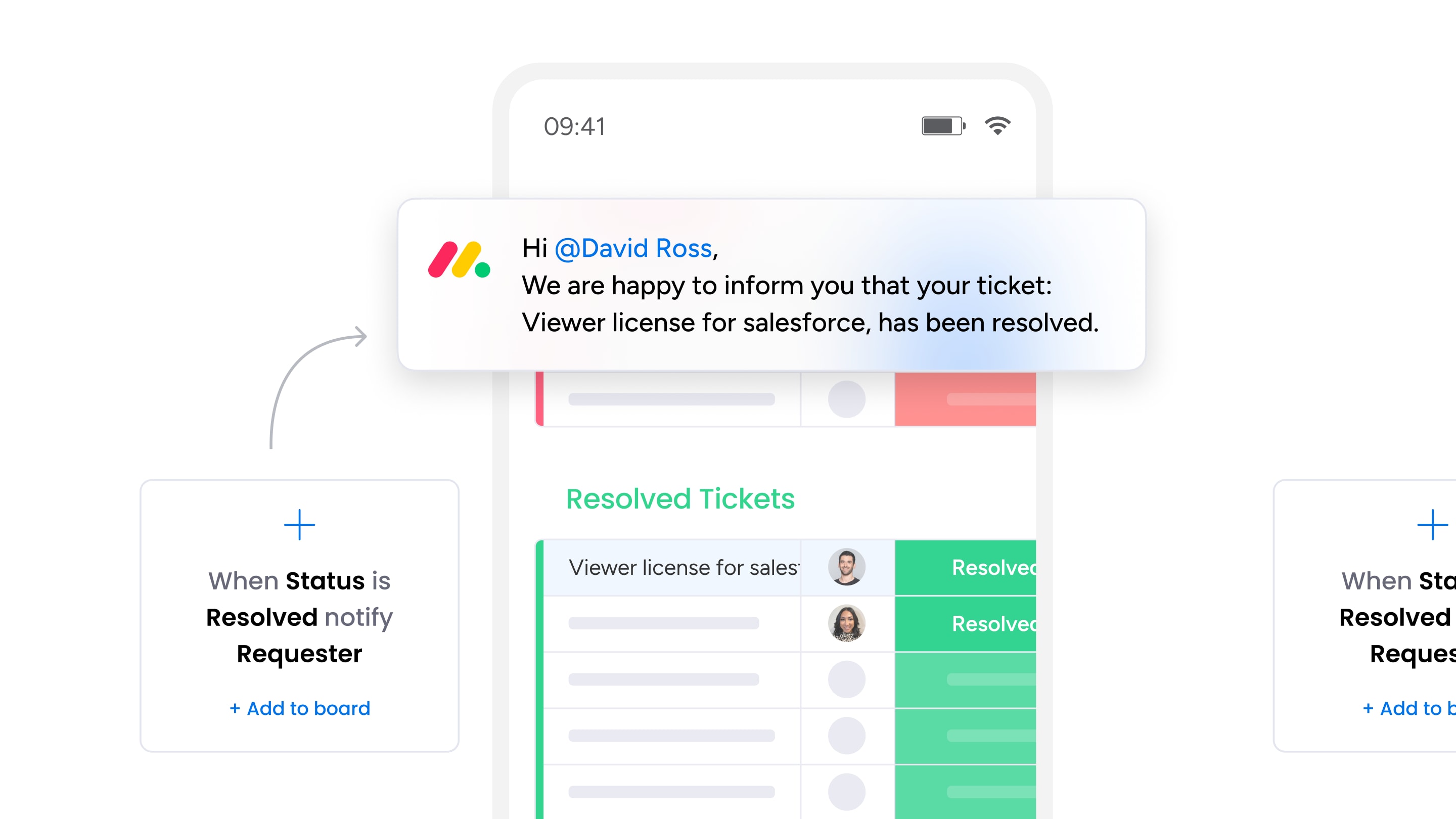
The best requirements management platforms compared
Identifying the best requirements management platform means looking beyond a simple inventory of specifications. The primary objective is to select a system that efficiently translates stakeholder requests into tangible, measurable results. Essentially, the right tool must seamlessly connect what is needed with what gets delivered.
Our evaluation of the leading contenders focused on core attributes that drive real-world success: intuitive design, robust integration capabilities, and functionalities that foster immediate team collaboration. These tools excel at transforming a disorganized collection of requirements into a smooth, predictable workflow, creating a clear path from initial request to final resolution that unifies your team’s efforts.
This lineup includes everything from highly specialized tools to all-in-one service platforms that manage the entire lifecycle. Some are designed for meticulous documentation, while others are powerhouses of automation and team collaboration. Consider this a guide to building your ideal software roster; we will help you find the solutions that best match your team’s strategy.
1. monday service
monday service transforms requirements management from a static documentation exercise into an active, collaborative process that connects directly to service delivery. The platform combines AI-powered automation with intuitive visual workflows, making it perfect for teams who need to bridge the gap between requirements gathering and actual implementation.
Built on the robust monday Work OS, it empowers cross-functional teams to manage requirements alongside broader service operations seamlessly.

Example: monday service excels at connecting requirements management directly to service delivery workflows, ensuring that documented requirements translate into actionable items and measurable outcomes.
Key features:
- Software Requirements Specification (SRS) templates: with customizable workflows for Agile, Scrum, and Waterfall methodologies.
- AI-powered automation: converts Product Requirements Documents into work items, assigns owners, and sets deadlines automatically.
- Real-time software development collaboration tools: with living documents that stay synchronized across teams and stakeholders.
Pricing:
- Free: $0 forever for up to two seats with three boards and basic templates.
- Basic: $9/seat/month (minimum three users) with unlimited items and 5GB storage.
- Standard: $12/seat/month with timeline views, guest access, and 250 automations per month.
- Pro: $19/seat/month with private boards, time tracking, and 25,000 automations per month.
- Enterprise: custom pricing with advanced security, 250,000 automations, and 24/7 support.
- Annual billing: saves 18% compared to monthly plans.
Why it stands out:
- Visual accessibility: the Visual Work OS approach makes requirements management accessible to non-technical stakeholders while maintaining the necessary depth for complex projects.
- Features native integration: between requirements documentation and service delivery workflows, effectively eliminating the typical disconnect between planning and execution.
- The AI assistant: automatically categorizes requirements, flags risks, and suggests next steps to accelerate the entire requirements lifecycle.
monday service top reviews

"Our team LOVES the monday service platform and we’re already exploring how we could incorporate it for other departments, too. It has streamlined our workflow in a way that both our team and customers appreciate."
Andrew Marshall | VP Operations
״monday service provides clear insights into requests volume and types, response times, and trends - helping us continuously improve operations"
Grant De Waal-Dubla | CIO"The biggest value for us is speed and flexibility. You can get up and running in days, change anything instantly, and see everything in real time. And you don’t need a dedicated admin to do it."
Clive Camilleri | Head of People Tech & Operations2. ServiceNow
ServiceNow delivers enterprise-scale requirements management through its unified platform that integrates strategic planning with execution workflows. The platform specializes in connecting business demands to development outcomes across complex organizational structures, making it ideal for large enterprises with intricate compliance and regulatory needs.

Example: ServiceNow integrates requirements management into broader business workflows, providing end-to-end visibility from initial demand capture through final delivery within a single platform ecosystem.
Key features:
- Demand management portal: centralizes and prioritizes all business and IT requests with built-in assessment workflows.
- Agile development capabilities: supporting Scrum methodologies with unified backlogs for both traditional and agile workstreams.
- Strategic portfolio management: connects requirements directly to business objectives and resource allocation decisions.
Pricing:
- Custom pricing: based on detailed evaluation of company needs.
- Scalable packages: available for different business growth stages.
- Flexible pricing models: tailored to specific organizational requirements.
- Contact ServiceNow: for personalized quotes.
Considerations:
- Implementation complexity: high implementation costs and complexity may require specialized expertise or dedicated implementation partners.
- Feature gaps: lacks dedicated requirements management features, which can be limiting for organizations with highly regulated or complex requirements processes.
3. Jira Service Management
Jira Service Management is a powerful ITSM platform that excels at connecting IT operations and support teams directly with development teams. It leverages the Atlassian ecosystem to create a smooth handoff between service requests and development work, helping everyone stay in sync.
While it’s primarily an IT service solution, its deep integration with Jira Software makes it a strong entry point for requirements.
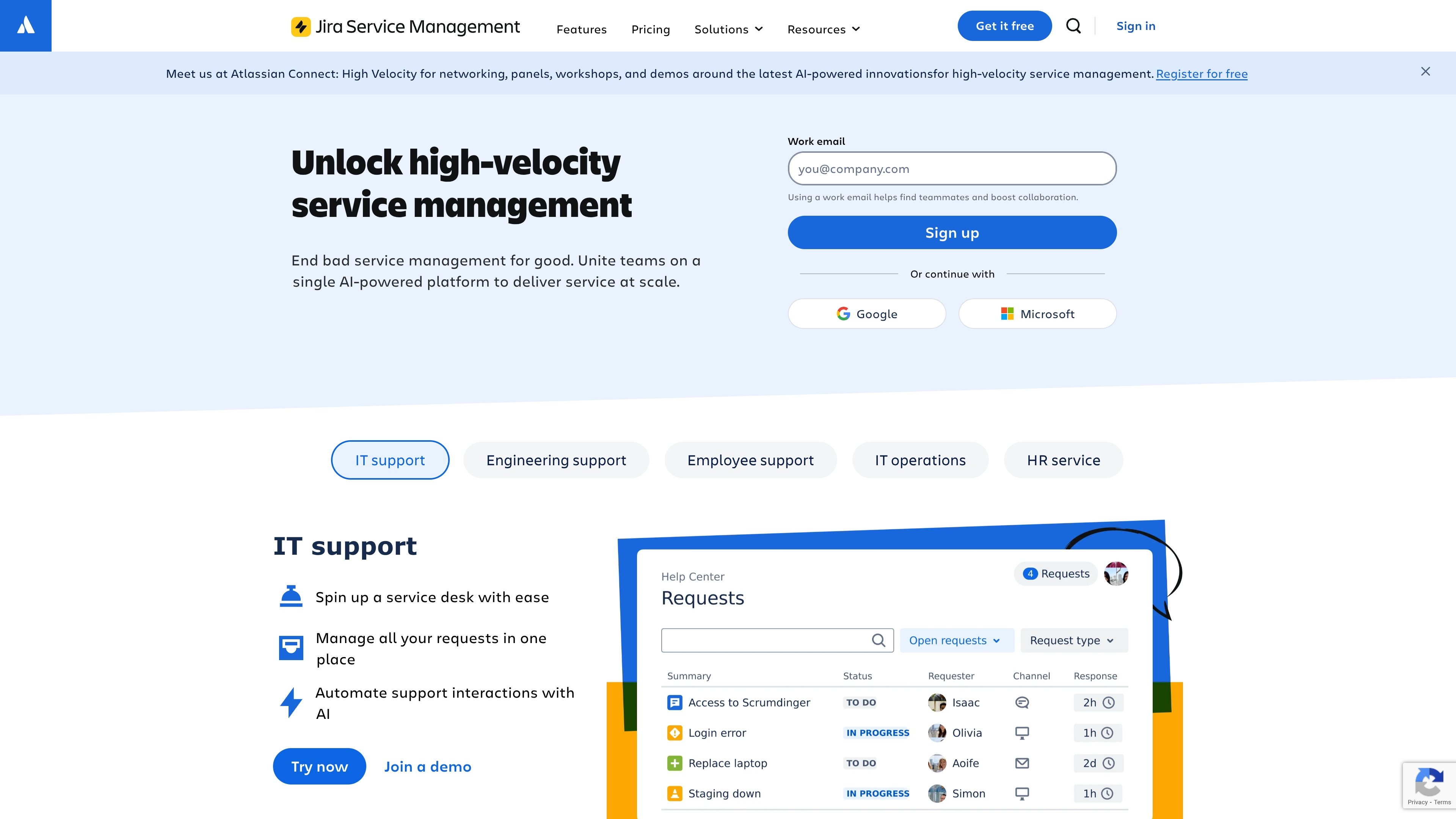
Example: this tool is ideal for bridging the gap between service requests and development. By integrating with Jira Software, JSM creates a unified workflow where support tickets or business requests can be directly converted into development tasks, ensuring nothing gets lost in translation.
Key features:
- Native integration with Jira Software: for end-to-end traceability from a service ticket to a finished feature.
- Customizable request forms and workflows: that can be tailored to capture specific details from business users.
- AI-powered virtual agents: to help automate support and resolve common requests, freeing up your teams to focus on more complex issues.
Pricing:
- Free: $0/month for up to three agents with 2 GB storage.
- Standard: $22.05/agent/month with 250 GB storage and up to 10,000 agents.
- Premium: $49.17/agent/month with unlimited storage and a 99.9% uptime SLA.
- Enterprise: contact sales for custom pricing with a 99.95% uptime SLA.
Considerations:
- Cost of the full ecosystem: its real power for requirements management comes from its tight integration with Jira Software and Confluence, so you will want to factor in the cost of the full ecosystem.
- Steep learning curve: the extensive customization options can create a steep learning curve for teams new to the Atlassian platform.
4. IBM Engineering Requirements Management DOORS Next
IBM DOORS Next delivers enterprise-grade requirements management with powerful traceability and compliance features for complex, regulated industries. The platform specializes in end-to-end lifecycle management within the broader IBM Engineering Lifecycle Management suite, making it ideal for aerospace, automotive, and medical device companies that need rigorous regulatory compliance.
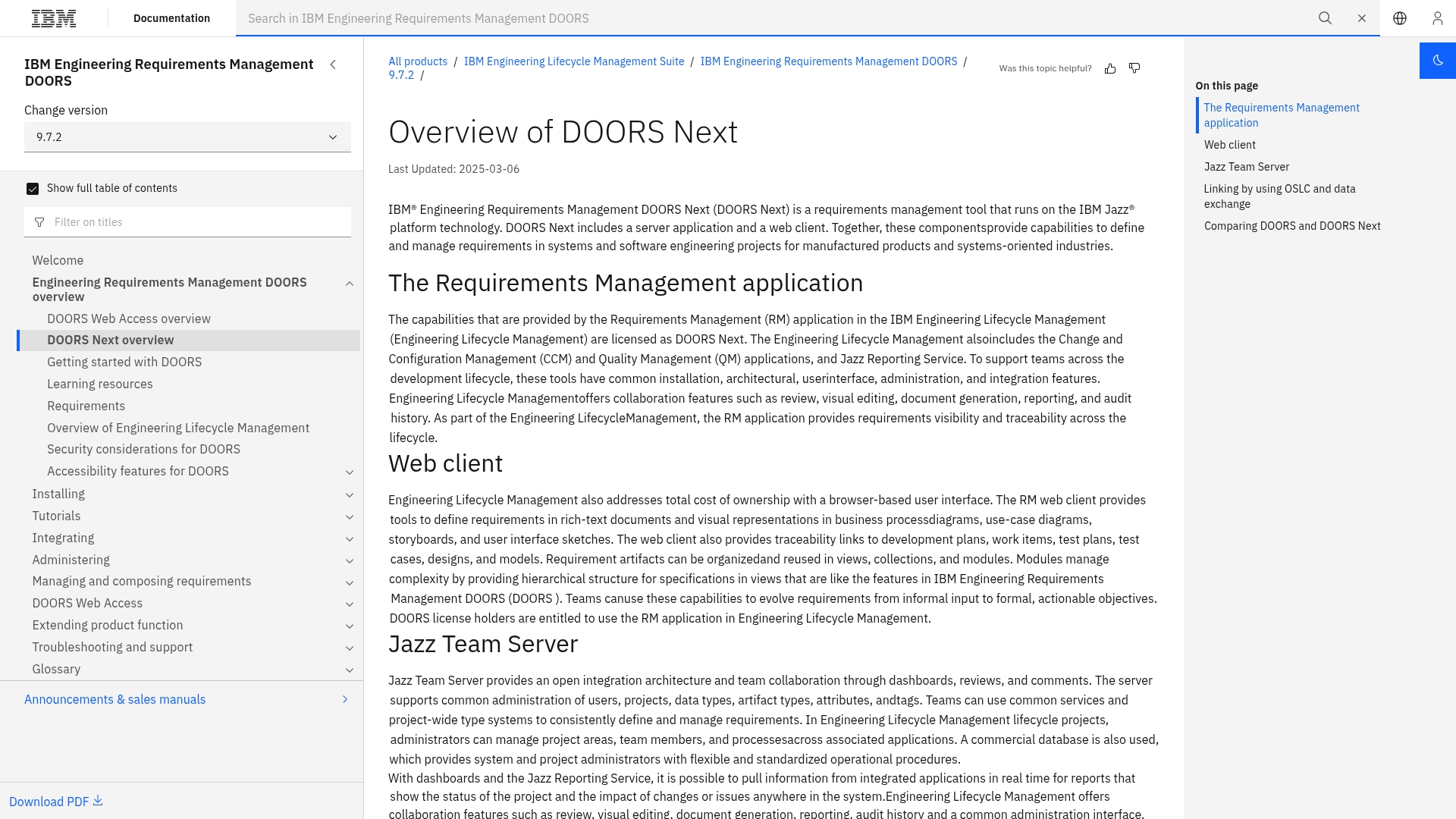
Example: IBM DOORS Next provides a centralized repository for managing complex requirements across the entire product development lifecycle, with robust traceability from initial stakeholder requirements through testing and implementation.
Key features:
- AI-enhanced requirements quality assistant: that improves requirement clarity as you write.
- Comprehensive traceability linking requirements: to test cases, designs, and work items across the development lifecycle.
- Advanced configuration management: with versioning, baselining, and support for product variants and parallel development streams.
Pricing:
- Pricing information: contact IBM sales.
Considerations:
- Steep learning curve and complex initial setup: that often requires expert assistance.
- High cost: may not be justifiable for smaller organizations or less complex requirements management needs.
5. Jama Software
Jama Software delivers comprehensive requirements management for complex product development teams. The platform specializes in Live Traceability™ across the entire development lifecycle, making it ideal for regulated industries like aerospace, automotive, and medical devices where compliance and risk management are critical.
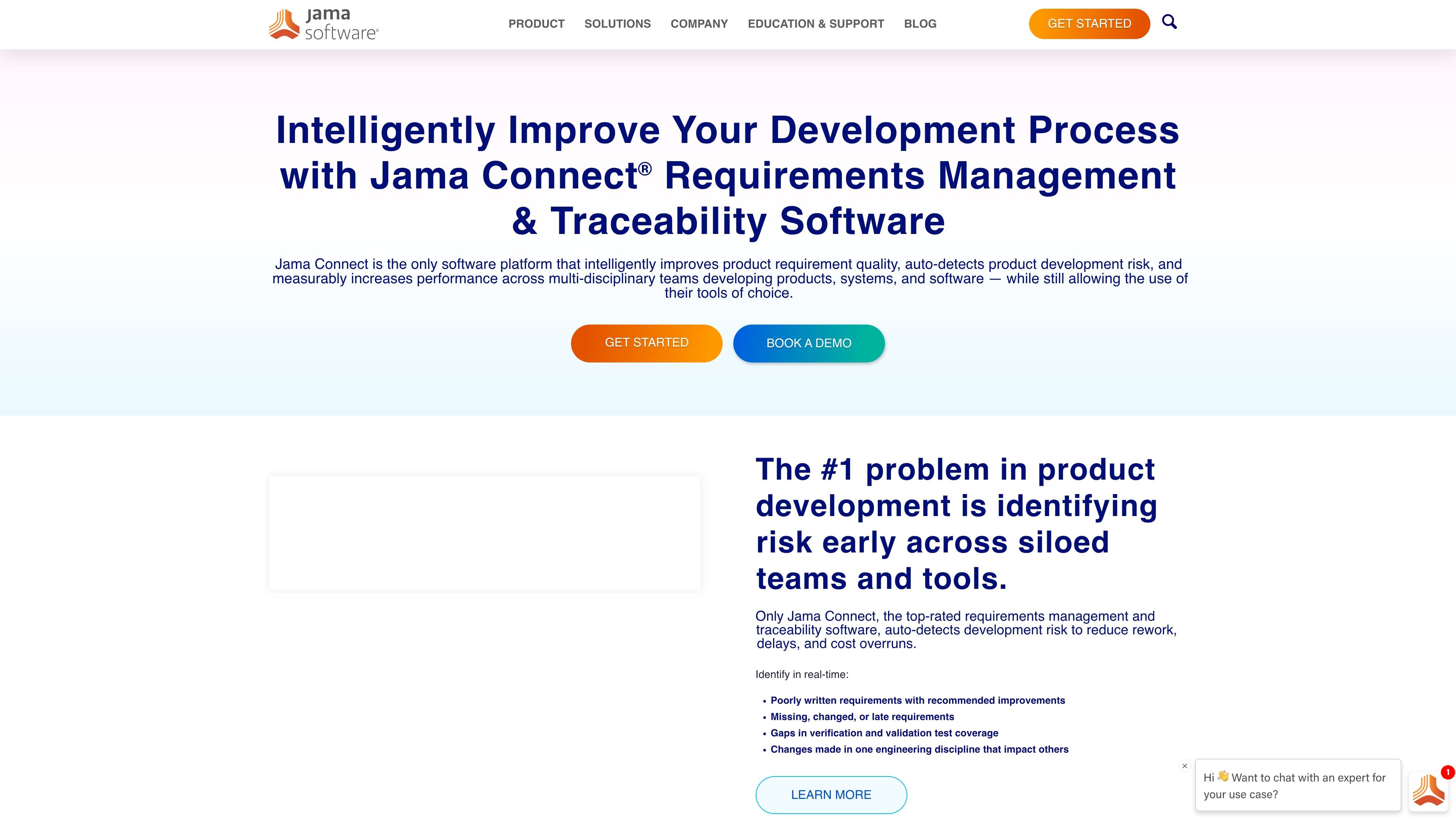
Example: Jama Software centralizes requirements management for organizations developing complex products that require end-to-end traceability, regulatory compliance, and cross-functional collaboration throughout the product development lifecycle.
Key features:
- Live Traceability™: provides real-time visibility into upstream and downstream relationships between requirements, test cases, and development artifacts.
- Requirements Quality Intelligence: uses AI and natural language processing to analyze and improve requirement statements against industry standards.
- Integrated test management capabilities: allow teams to create, manage, and trace test cases directly back to requirements for complete verification.
Pricing:
- Custom pricing: based on user license types: Creator (full access), Stakeholder (limited view/comment), Reviewer (participate in reviews), and Test Runner (test functionality).
- No extra charges: for hosting, reviewer licenses, API usage, file storage, or hosted sandbox environments.
- Contact Jama Software: for detailed pricing quotes.
Considerations:
- UI/Performance issues: user interface can feel outdated or “clunky” at times, with occasional performance delays when loading large projects.
- Learning curve requirements: for advanced features like custom reporting requires significant training and setup time.
6. Polarion
Polarion delivers comprehensive application lifecycle management with deep requirements traceability for complex, regulated industries. The platform specializes in unified ALM capabilities through its browser-based environment, making it ideal for automotive, aerospace, and medical device organizations that need rigorous compliance and end-to-end visibility.

Example: Polarion excels at managing complex requirements across the entire product development lifecycle while maintaining complete traceability for regulatory compliance and audit readiness.
Key features:
- LiveDocs™ technology: enables real-time collaborative editing in a familiar document interface while maintaining granular work item tracking.
- Built-in ReqIF support and IBM DOORS integration: facilitate seamless requirements exchange with customers and suppliers.
- Automated change control and suspect linking: ensure every modification is tracked with full audit trails for compliance.
Pricing:
- Contact sales: for custom quotes based on Named User or Concurrent User licensing.
- Annual support and maintenance: at 20% of license cost (required first year).
- Special pricing: available for academic, open source, and government organizations through reseller partners.
Considerations:
- Steep learning curve and complex initial setup: may require significant training investment and onboarding time.
- Performance issues: can slow when working with very large documents or complex LiveDocs, potentially impacting productivity for extensive projects.
7. ReqView
ReqView delivers Git-based requirements management specifically designed for hardware and software development teams in regulated industries. The platform combines the simplicity of document-based workflows with powerful version control and traceability features, making it perfect for small to midsize companies that need compliance without complexity. Its offline collaboration capabilities and open file format ensure teams can work flexibly while avoiding vendor lock-in.

Example: ReqView provides an affordable, document-centric approach to requirements management that helps regulated industries maintain compliance while enabling distributed teams to collaborate offline through Git-based version control.
Key features:
- End-to-end traceability: with live matrix views for impact analysis and coverage tracking.
- Git and Subversion integration: for version control with human-readable JSON data storage.
- Customizable templates: supporting ISO/IEC/IEEE 29148, OWASP ASVS, and FMEA standards.
Pricing:
- Free: limited features with one document, one custom attribute, up to 150 objects.
- Pro: $510/year per user with full requirements management and export capabilities.
- Team: $690/year per user adding dashboard views, integrations, and project linking.
- Enterprise: $2,060/year per floating client (minimum 3 clients) for unlimited users and flexible licensing.
- Educational: free for universities and educational use only.
- Trial: 14-day free access to Team plan features.
Considerations:
- Limited real-time collaboration features: compared to cloud-based competitors.
- Desktop application focus: may not suit teams preferring web-based solutions.
How to select the right requirements management solution
Selecting the right requirements management solution is a strategic decision that should align with your team’s unique operational rhythm, not just a feature-by-feature comparison. The best platforms integrate so naturally that they enhance collaboration from day one and scale with your needs rather than constraining them.
Prioritize platforms that offer deep flexibility, enabling the construction of bespoke workflows that mirror your team’s processes without imposing rigid structures. True power is unlocked when everyone, from frontline staff to leadership, has a clear, real-time view of progress. This shared visibility is the key to dismantling departmental silos and solving challenges collectively.
An ideal solution (like monday service) provides powerful, no-code customizations that your team can implement independently. It must also connect seamlessly with the tools you already depend on and deliver intelligent, real-time analytics.
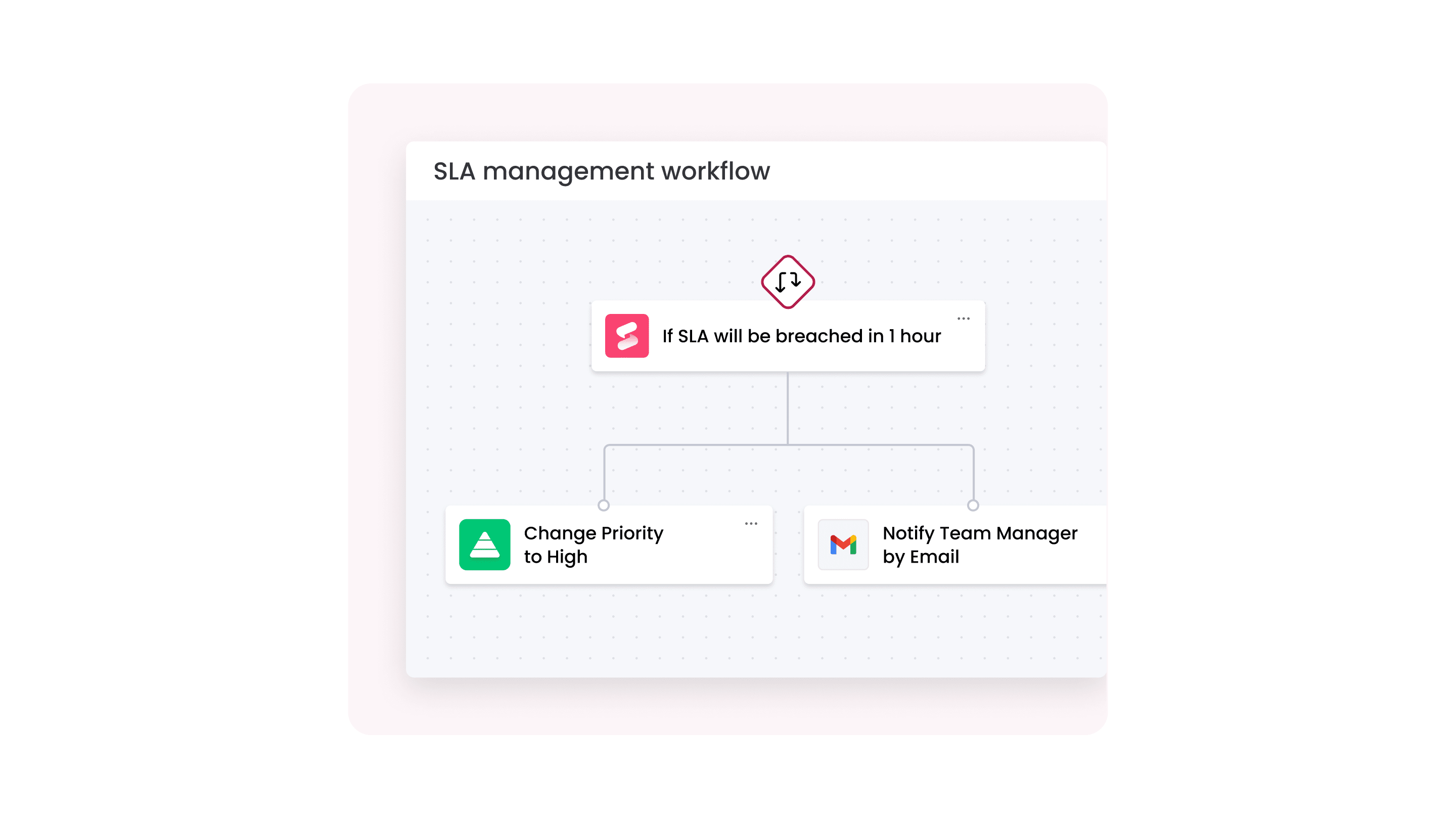
AI and the future of requirements management
Artificial intelligence (AI) is fundamentally transforming requirements management, offering a strategic advantage by balancing meticulous detail with rapid execution.
- Mastering the balance: AI enables teams to move beyond a reactive ‘catch-up’ approach to a forward-thinking strategy, ensuring projects stay on track from inception.
- Strategic asset: beyond automating routine tasks, AI acts as a strategic asset by intelligently routing requirements to the right personnel and proactively identifying potential bottlenecks before they escalate.
- Orchestrating success: this shift moves the focus from simple task management to orchestrating success, ensuring all contributors are aligned and empowered.
- Working smarter: platforms like monday service embed this intelligence to learn a team’s unique rhythm, automating tasks and delivering insights that facilitate effortless scaling, allowing teams to work smarter, not harder.
Where integrated management leads
Transitioning from manual tracking to an integrated system represents a fundamental evolution in how work is managed. It marks a shift from chasing details in spreadsheets to relying on an intelligent platform that anticipates needs and connects every facet of the operation. This is how scattered requests are consolidated into a clear, unified plan that everyone can execute.
Housing requirements, service tickets, and project items within a single platform creates a unified workflow. This deep integration accelerates resolution times, keeps projects perfectly aligned with their goals, and frees your team to focus on high-impact wins instead of administrative overhead.
Platforms like monday service are designed to bridge these gaps, turning siloed tasks into a seamless, collaborative workflow.
The content in this article is provided for informational purposes only and, to the best of monday.com’s knowledge, the information provided in this article is accurate and up-to-date at the time of publication. That said, monday.com encourages readers to verify all information directly.
Frequently asked questions
What is the difference between requirements management software and project management software?
The difference between requirements management software and project management software is that the former focuses on defining the "what" of a project, while the latter organizes the "how" and "when." Platforms like monday service integrate both, connecting your requirements directly to your execution and service delivery workflows.
Can requirements management software integrate with existing development platforms?
Yes, modern platforms integrate with development tools, version control systems, and CRMs through APIs and pre-built connectors. monday service connects your requirements to all your key organizational resources, creating a single, unified workflow for your team.
Do requirements management platforms support regulatory compliance?
Absolutely; many platforms include features like audit trails, e-signatures, and automated reporting to meet strict compliance standards. The best tools make this data actionable, helping you easily generate reports and satisfy regulatory auditors.
How does AI improve requirements traceability in modern platforms?
AI automates traceability by intelligently linking requirements to test cases, design elements, and deliverables, saving your team countless hours. This technology also proactively identifies potential conflicts and dependencies, helping you optimize service delivery.
What industries benefit most from specialized requirements management software?
Highly regulated industries like automotive, aerospace, and medical devices benefit greatly, but any team can improve its service delivery with structured requirements. Clear requirement tracking helps IT, customer service, and operations teams deliver more consistent, high-quality outcomes.
Are there free requirements management software options available?
Yes, some platforms offer free plans with basic features, which are great for small teams or pilot projects. However, these often have limitations, and growing teams typically need a scalable solution to support their entire service delivery ecosystem.
 Get started
Get started

